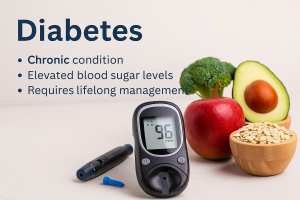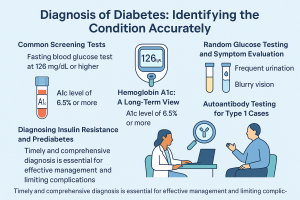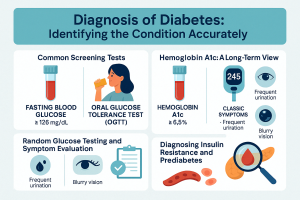დიაბეტის მიზეზები: გამომწვევი მიზეზების გაგება
გლუკოზასთან დაკავშირებული ჯანმრთელობის პრობლემები, რომელსაც ჩვეულებრივ მეტაბოლურ პირობებს უწოდებენ, ვითარდება მაშინ, როდესაც ორგანიზმი სათანადოდ ვერ არეგულირებს სისხლში შაქრის დონეს. ეს დარღვევები ზოგადად კლასიფიცირდება რამდენიმე კატეგორიად, მათ შორის ყველაზე ფართოდ აღიარებული არის აუტოიმუნური დაწყება (ჩვეულებრივ ახალგაზრდობაში), ცხოვრების წესთან დაკავშირებული ინსულინის წინააღმდეგობა და ორსულობასთან დაკავშირებული დროებითი ჰორმონალური დისბალანსი. თითოეულ ფორმას აქვს განსხვავებული მიზეზები, თუმცა ისინი ხშირად იზიარებენ რისკ-ფაქტორებს.
The დიაბეტის სიმპტომები მოზრდილებში ხშირად ოდნავ განსხვავდება ბავშვებისგან, დაღლილობა და ჭრილობების ნელი შეხორცება უფრო ხშირია.
იმ შემთხვევებში, როდესაც იმუნური სისტემა შეცდომით მიზნად ისახავს და ანადგურებს პანკრეასის უჯრედებს, რომლებიც პასუხისმგებელნი არიან ინსულინის წარმოებაზე, ინდივიდებს ხშირად უსვამენ დიაგნოზს ბავშვობაში ან მოზარდობაში. ეს ტიპი ითვლება აუტოიმუნურ რეაქციად და მიუხედავად იმისა, რომ ზუსტი მიზეზი უცნობია, მკვლევარები თვლიან, რომ გენეტიკური მიდრეკილება, გარკვეული ვირუსების ზემოქმედება და გარემო ელემენტები, როგორიცაა ტოქსინები ან დამაბინძურებლები, შეიძლება იყოს ხელშემწყობი ფაქტორები. თუ ახლო ნათესავს აქვს მსგავსი მდგომარეობა, დაავადების განვითარების შანსი მნიშვნელოვნად იზრდება.
მეორეს მხრივ, მოზრდილებში დაწყებული ვარიანტი, რომელიც ახლა ხშირად გვხვდება ახალგაზრდებშიც, გამოწვეულია ინსულინის წინააღმდეგობის გახანგრძლივებული პერიოდებით. ეს მდგომარეობა ჩნდება მაშინ, როდესაც სხეულის უჯრედები ნაკლებად რეაგირებენ ინსულინზე, რაც იწვევს სისხლში გლუკოზის დაგროვებას. ძირითადი წვლილი მოიცავს ჭარბ წონას, დამუშავებული საკვების და შაქრიანი სასმელების დიდ მოხმარებას, რეგულარული ვარჯიშის ნაკლებობას და სტრესს. შაქრის დისბალანსის ეს ფორმა თანდათან ვითარდება და დიდ გავლენას ახდენს როგორც გენეტიკაზე, ასევე ცხოვრების სტილის არჩევანზე.
ორსულობამ ასევე შეიძლება გამოიწვიოს ინსულინის ფუნქციონირების დროებითი დარღვევები. ეს სპეციფიკური მდგომარეობა, როგორც წესი, ჩნდება მეორე ან მესამე ტრიმესტრში, როდესაც ჰორმონები ხელს უშლიან ორგანიზმში ინსულინის გამოყენებას. მიუხედავად იმისა, რომ ის ჩვეულებრივ ქრება მშობიარობის შემდეგ, ეს მიუთითებს მომავალში შაქრის რეგულირების უფრო სერიოზული პრობლემების განვითარების რისკზე, განსაკუთრებით იმ შემთხვევაში, თუ არ არის მიღებული პრევენციული ზომები.
ასევე არსებობს ნაკლებად გავრცელებული, მაგრამ თანაბრად მნიშვნელოვანი ტრიგერები. ცნობილია, რომ ქრონიკული სტრესი ზრდის კორტიზოლის დონეს, რამაც შეიძლება დაარღვიოს ინსულინის მგრძნობელობა. ისეთი მედიკამენტების ხანგრძლივმა გამოყენებამ, როგორიცაა კორტიკოსტეროიდები ან ანტიფსიქოტიკა, ასევე შეიძლება გამოიწვიოს სისხლში შაქრის დაქვეითება. ენდოკრინული დარღვევები, როგორიცაა კუშინგის სინდრომი ან ჰორმონალური დისბალანსი, როგორიცაა პოლიკისტოზური საკვერცხეების სინდრომი (PCOS), კიდევ უფრო ზრდის მეტაბოლური პრობლემების განვითარების ალბათობას.
საუკეთესო საკვები დიაბეტით დაავადებულთათვის
ზოგიერთი საუკეთესო საკვები დიაბეტით დაავადებულთათვის მოიცავს ფოთლოვან მწვანილს, კენკრას, პარკოსნებს და ბოჭკოვან მაღალ საკვებს.
ინფექციები, მათ შორის გარკვეული ვირუსული აგენტები, ასევე ასოცირდება აუტოიმუნური შაქრის დარღვევებთან. ეს ინფექციები შეიძლება მოქმედებდეს როგორც კატალიზატორი, განსაკუთრებით გენეტიკურად მიდრეკილ პირებში. მიუხედავად იმისა, რომ ზუსტი გზები ჯერ კიდევ გამოძიების პროცესშია, ბევრი მკვლევარი თანხმდება, რომ გარემოს ზემოქმედება გენეტიკურ დაუცველობასთან ერთად ქმნის ამ პირობების საფუძველს.
გლუკოზის დისბალანსის წარმოშობის გაგება აუცილებელია არა მხოლოდ ადრეული დიაგნოზისთვის, არამედ ეფექტური პრევენციის სტრატეგიების შემუშავებისთვის. სხვადასხვა მიზეზების ამოცნობით - ცხოვრების წესიდან და დიეტადან დაწყებული გენეტიკური და ჰორმონალური ცვლილებებით დამთავრებული - ინდივიდებს შეუძლიათ გააკონტროლონ თავიანთი გრძელვადიანი კეთილდღეობა. რეგულარული გამოკვლევები, დაბალანსებული კვება, სტრესის მართვა და ფიზიკურად აქტიური ყოფნა ყველა როლს ასრულებს ამ უწყვეტი პირობების რისკის შემცირებაში.

დიაბეტის სიმპტომები: მდუმარე სიგნალების დანახვა
სიმპტომების ადრეული ამოცნობა შეიძლება შეცვალოს სიცოცხლე დიაბეტის განვითარების რისკის მქონე პირებისთვის. ხშირად მოიხსენიება, როგორც ჩუმ მდგომარეობა, სისხლში შაქრის ეს დარღვევა ადრეულ სტადიაზე შეიძლება გამოვლინდეს დახვეწილი ნიშნებით. ვინაიდან გლუკოზის ამაღლებულმა დონემ შეიძლება გავლენა მოახდინოს სხეულის მრავალ სისტემაზე, სიმპტომების მრავალფეროვნება ფართოა და შეიძლება ოდნავ განსხვავდებოდეს ინდივიდებს შორის. თუმცა, არსებობს გარკვეული დამახასიათებელი ნიშნები, რომლებიც ხშირად არის მოხსენებული და არასოდეს არ უნდა იყოს იგნორირებული.
სწავლის შესახებ დიაბეტის სიმპტომები და მკურნალობა ეხმარება ინდივიდებს ადრეულ რეაგირებაში და თავიდან აიცილონ გრძელვადიანი გართულებები.
ერთ-ერთი ყველაზე გავრცელებული ადრეული სიმპტომია მუდმივი წყურვილი, მედიცინაში ცნობილი როგორც პოლიდიფსია. როდესაც სისხლში შაქრის დონე მაღალია, სხეული ცდილობს მის გამოდევნას შარდვის გზით, რაც იწვევს დეჰიდრატაციას. შედეგად, დაზარალებული პირები ხშირად განიცდიან წყლის დალევის დაუოკებელ მოთხოვნილებას. ამ სიმპტომს ხშირად თან ახლავს ჭარბი შარდვა, განსაკუთრებით ღამის საათებში (მდგომარეობა, რომელსაც ეწოდება ნოქტურია). თუ რამდენჯერმე იღვიძებთ აბაზანის გამოსაყენებლად, ეს შეიძლება მიუთითებდეს უფრო ღრმა მეტაბოლურ დისბალანსზე.
კიდევ ერთი ძირითადი სიმპტომია უჩვეულო დაღლილობა. რეგულარულად ჭამის მიუხედავად, ადამიანებმა შეიძლება იგრძნონ დაღლილობა ან დუნე, რადგან სხეულს არ შეუძლია ეფექტურად გარდაქმნას გლუკოზა გამოსაყენებელ ენერგიად. ენერგიის ეს დეფიციტი გავლენას ახდენს როგორც ფიზიკურ გამძლეობაზე, ასევე გონებრივ სიცხადეზე. ამოცანები, რომლებიც ოდესღაც ადვილი იყო, შეიძლება სულ უფრო რთული გახდეს და კონცენტრაცია შეიძლება დაზარალდეს. წონის აუხსნელი კლება ასევე წითელი დროშაა, განსაკუთრებით იმ შემთხვევებში, როდესაც საკვების მიღება უცვლელი რჩება. გლუკოზას მოკლებული სხეული იწყებს კუნთებისა და ცხიმის მარაგების დაშლას კომპენსაციისთვის.
მხედველობის დაბინდვა ხშირი ჩივილია, რომელიც შეიძლება გაჩნდეს დიაგნოზამდეც კი. შაქრის მაღალი დონე სითხეს აწვება თვალის ლინზებში, რაც იწვევს შეშუპებას და აქცენტის დამახინჯებას. მძიმე ან გახანგრძლივებულ შემთხვევებში, ეს შეიძლება გადაიზარდოს ისეთ მდგომარეობებამდე, როგორიცაა დიაბეტური რეტინოპათია, რამაც შეიძლება გამოიწვიოს მხედველობის მუდმივი დაკარგვა, თუ ეს არ არის გამოსწორებული. თვალის რეგულარული გამოკვლევები დაგეხმარებათ ასეთი ცვლილებების ადრეულ გამოვლენაში და გრძელვადიანი თვალის ჯანმრთელობის დაცვაში.
დამატებითი სიმპტომებია ჭრილობების ნელი შეხორცება, კანის ხშირი ინფექციები და იმუნური პასუხის ზოგადი დაქვეითება. მცირე ჭრილობების ან სისხლჩაქცევების შეხორცებას შეიძლება უჩვეულოდ დიდი დრო დასჭირდეს ცუდი მიმოქცევისა და იმუნური სისტემის დაქვეითების გამო, რომელიც გამოწვეულია გლუკოზის ტოქსიკურობით. ინდივიდებმა შეიძლება შეამჩნიონ ჩხვლეტა, დაბუჟება ან ტკივილი ხელებსა და ტერფებში - ნერვის დაზიანების ადრეული ინდიკატორი, რომელიც ცნობილია როგორც პერიფერიული ნეიროპათია. ეს სიმპტომები ხშირად უარესდება გლუკოზის სათანადო კონტროლის გარეშე.
ადამიანებს, რომლებსაც აქვთ ინსულინრეზისტენტობა, შეიძლება განუვითარდეთ კანის ისეთი დაავადებები, როგორიცაა აკანტოზი ნიგრიკანსი, რომელიც ჩნდება ჩაბნელებული, ხავერდოვანი ლაქების სახით სხეულის ნაკეცებში, როგორიცაა კისერი, იღლიები ან საზარდული. ეს მდგომარეობა ხშირად უფრო ღრმა მეტაბოლური დისფუნქციის გარეგანი მარკერია. ქალებს ასევე შეიძლება აწუხებდეთ განმეორებადი საფუარის ინფექციები, ხოლო მამაკაცებს შეიძლება განიცადონ ბალანიტი - სოკოს ჭარბი ზრდის შედეგად გამოწვეული ანთება.
ამ ნიშნების გაგება სასიცოცხლოდ მნიშვნელოვანია, განსაკუთრებით მათთვის, ვისაც აქვს ოჯახის ისტორია ან სხვა რისკფაქტორები. სიმპტომების ადრეული გამოვლენა აუმჯობესებს შედეგებს და ამცირებს სერიოზული გართულებების ალბათობას. თუ რამდენიმე ნიშანი ერთდროულად გამოჩნდება, მიზანშეწონილია მიმართოთ ჯანდაცვის პროფესიონალს სისხლში შაქრის ტესტისა და შემდგომი შეფასებისთვის.

არანამკურნალევი დიაბეტის გართულებები: ფარული საფრთხეები
ადრეული ნიშნების იგნორირება სისხლში შაქრის დისბალანსმა შეიძლება გამოიწვიოს სერიოზული, ზოგჯერ შეუქცევადი გართულებების ფართო სპექტრი. მიუხედავად იმისა, რომ მდგომარეობა შეიძლება დაიწყოს რბილი სიმპტომებით, როგორიცაა დაღლილობა ან გაზრდილი წყურვილი, ხანგრძლივი უგულებელყოფა საშუალებას აძლევს გლუკოზის დონეს დააზიანოს ორგანოები და სხეულის სისტემები. იქნება ეს არასაკმარისი ინფორმირებულობის, არასწორი დიაგნოზის ან ცუდი ცხოვრების წესის გამო, არანამკურნალევმა შემთხვევებმა შეიძლება მნიშვნელოვნად შეამციროს ცხოვრების ხარისხი და შეამციროს სიცოცხლის ხანგრძლივობა.
გულ-სისხლძარღვთა და სისხლის მიმოქცევის სისტემის დაზიანება
გლუკოზის უმართავი დარღვევების ერთ-ერთი ყველაზე მძიმე შედეგი არის გულის დაავადება. შაქრის ქრონიკულად ამაღლებული დონე ზრდის ათეროსკლეროზის რისკს - მდგომარეობა, როდესაც არტერიები იკეტება ცხიმოვანი დეპოზიტებით. ეს ზრდის გულის შეტევის, ინსულტის და ჰიპერტენზიის ალბათობას. გარდა ამისა, კიდურებში ცუდი მიმოქცევა შეიძლება გამოიწვიოს პერიფერიული არტერიის დაავადება, რომელიც ზღუდავს სისხლის ნაკადს და ზრდის ინფექციის, წყლულების ან თუნდაც კიდურების ამპუტაციის შანსს ექსტრემალურ შემთხვევებში.
თირკმლის დისფუნქცია და თირკმლის უკმარისობა
თირკმელები განსაკუთრებით დაუცველია მაღალი გლუკოზის ხანგრძლივი ზემოქმედების მიმართ. დროთა განმავლობაში თირკმელების პაწაწინა სისხლძარღვები ზიანდება, რაც ამცირებს ნარჩენების ეფექტურად გაფილტვრის უნარს. ეს მდგომარეობა, რომელიც ცნობილია როგორც დიაბეტური ნეფროპათია, არის თირკმელების უკმარისობის ერთ-ერთი წამყვანი მიზეზი მსოფლიოში. მოწინავე სტადიაზე, პაციენტებს შეიძლება დასჭირდეთ დიალიზი ან თირკმლის ტრანსპლანტაცია გადარჩენისთვის. ასეთი შედეგების თავიდან ასაცილებლად აუცილებელია სისხლში შაქრის დონის ადრეული გამოვლენა და კონტროლი.
მხედველობის დაქვეითება და თვალის დაავადება
გლუკოზის ამაღლებულმა დონემ შეიძლება პირდაპირი გავლენა მოახდინოს მხედველობაზე. მასთან დაკავშირებული ყველაზე ცნობილი მდგომარეობაა დიაბეტური რეტინოპათია, სადაც დაზიანებულია ბადურის სისხლძარღვები. თუ დროულად არ განიხილება, ის შეიძლება გადაიზარდოს სრულ სიბრმავემდე. თვალის დამატებით გართულებებს მიეკუთვნება კატარაქტა და გლაუკომა, ორივე მათგანი უფრო გავრცელებულია გრძელვადიანი მეტაბოლური პრობლემების მქონე პირებში. თვალის რეგულარული შემოწმება დაავადების მართვის განუყოფელი ნაწილია.
ნერვის დაზიანება და ნეიროპათია
სისხლში შაქრის გახანგრძლივებული მაღალი დონე იწვევს ნერვების მნიშვნელოვან დაზიანებას, რომელიც ჩვეულებრივ ვლინდება როგორც ჩხვლეტა, დაბუჟება ან წვის ტკივილი, განსაკუთრებით ხელებსა და ტერფებში. ეს მდგომარეობა ცნობილია როგორც დიაბეტური ნეიროპათია. მძიმე შემთხვევებში, ინდივიდებმა შეიძლება დაკარგონ ყველა შეგრძნება დაზიანებულ ადგილებში, რაც იწვევს შეუმჩნეველ დაზიანებებს ან ინფექციებს. საჭმლის მომნელებელი სისტემის ნერვები ასევე შეიძლება დაზარალდეს, რამაც გამოიწვია გულისრევა, ყაბზობა ან გასტროპარეზი - კუჭის დაგვიანებული დაცლა.
კოგნიტური დაქვეითება და ფსიქიკური ჯანმრთელობის ეფექტები
ბოლო კვლევებმა აჩვენა კორელაცია სისხლში შაქრის ქრონიკულ პრობლემებსა და კოგნიტურ დარღვევებს შორის, როგორიცაა ალცჰეიმერის დაავადება და სისხლძარღვთა დემენცია. გარდა ამისა, ცუდად მართვადი პირობების მქონე პირები უფრო მიდრეკილნი არიან დეპრესიისა და შფოთვისკენ, რაც ქმნის ნეგატიურ ციკლს, რაც კიდევ უფრო ართულებს თავის მოვლას და დაავადების მართვას.
მოკლედშაქრის რეგულირების დარღვევის ყველაზე მსუბუქ სიმპტომებსაც კი ვერ მივაღწევთ, შეიძლება გამოიწვიოს ფართო გართულებები. დროულმა დიაგნოზმა, მედიკამენტების დაცვამ, ჯანსაღი კვება და რეგულარული მონიტორინგი შეიძლება მნიშვნელოვნად შეამციროს ეს რისკები და გამოიწვიოს უფრო ხანგრძლივი, ჯანსაღი ცხოვრება.
დიაბეტის დიაგნოზი: მდგომარეობის ზუსტად განსაზღვრა
ზუსტი დიაგნოზი ფუნდამენტურ როლს თამაშობს ნებისმიერი მეტაბოლური დარღვევის ეფექტურად მართვაში. ადრეული გამოვლენა საშუალებას აძლევს ინდივიდებს დაიწყონ ცხოვრების წესის შეცვლა და სამედიცინო თერაპია გართულებების წარმოშობამდე. სისხლში შაქრის დისბალანსის დიაგნოსტიკა მოიცავს ლაბორატორიული ტესტირების, სამედიცინო ისტორიის შეფასებას და სიმპტომების შეფასებას. რაც უფრო ადრე დადასტურდება მდგომარეობა, მით მეტია გრძელვადიანი ჯანმრთელობის შენარჩუნების შანსი.
საერთო სკრინინგის ტესტები
ორგანიზმში გლუკოზის რეგულირების შესაფასებლად გამოიყენება რამდენიმე რუტინული ტესტი. ყველაზე ფართოდ გამოიყენება სისხლში გლუკოზის უზმოზე ტესტი, რომელიც ზომავს შაქრის დონეს ღამის მარხვის შემდეგ. 126 მგ/დლ ან უფრო მაღალი შედეგი ორ ცალკეულ შემთხვევაში, როგორც წესი, მიუთითებს შაქრის მეტაბოლიზმის ქრონიკულ დარღვევაზე. კიდევ ერთი ტესტი, ორალური გლუკოზის ტოლერანტობის ტესტი (OGTT), აფასებს სხეულის რეაქციას შაქრიან სასმელზე გლუკოზის დონის შემოწმებით, მიღებიდან გარკვეული ინტერვალებით. ეს განსაკუთრებით სასარგებლოა ორსულობის დროს გესტაციური პრობლემების დასადგენად.
ჰემოგლობინი A1c: გრძელვადიანი ხედი
ჰემოგლობინის A1c ტესტი იძლევა ხედვას სისხლში შაქრის საშუალო დონის შესახებ ბოლო ორი-სამი თვის განმავლობაში. A1c მაჩვენებელი 6.5% ან უფრო მაღალი ზოგადად ადასტურებს დიაგნოზს. ეს ტესტი ძალზე ღირებულია არა მხოლოდ მდგომარეობის იდენტიფიცირებისთვის, არამედ დროთა განმავლობაში მკურნალობის ეფექტურობის თვალყურის დევნებისთვის. ის გახდა ოქროს სტანდარტი დიაბეტის მართვის პროტოკოლებში გლობალურად.
გლუკოზის შემთხვევითი ტესტირება და სიმპტომების შეფასება
გლუკოზის შემთხვევითი ტესტირება, რომელიც ტარდება ჭამის დროის გათვალისწინების გარეშე, ასევე შეიძლება გამოყენებულ იქნას გადაუდებელ ან სიმპტომურ შემთხვევებში. თუ მაჩვენებელი აღემატება 200 მგ/დლ-ს და თან ახლავს კლასიკური სიმპტომები, როგორიცაა ხშირი შარდვა ან ბუნდოვანი მხედველობა, დიაგნოზი შეიძლება დაუყონებლივ დაისვას. ხშირ შემთხვევაში, ჯანდაცვის პროვაიდერი ასევე იკითხავს დაღლილობის, წონის მოულოდნელ ცვლილებებზე, ინფექციებსა და კანის მდგომარეობაზე, რათა წარმართოს ტესტირების გადაწყვეტილებები.
ავტოანტისხეულების ტესტირება 1 ტიპის შემთხვევებისთვის
აუტოიმუნურ ვარიანტში ეჭვმიტანილ პირებში - ხშირად ბავშვებს ან მოზარდებში - გამოიყენება ავტოანტისხეულების ტესტირება. ეს სისხლის ტესტები ამოწმებს ანტისხეულებს, რომლებიც თავს ესხმიან პანკრეასის ინსულინის წარმომქმნელ უჯრედებს. აღმოჩენის შემთხვევაში, ისინი ეხმარება განასხვავონ გლუკოზასთან დაკავშირებული პირობების სხვადასხვა ფორმები და უზრუნველყონ, რომ პაციენტი თავიდანვე მიიღებს სწორ მკურნალობას.
ინსულინის რეზისტენტობისა და პრედიაბეტის დიაგნოსტიკა
იმ პირებში, რომლებსაც შესაძლოა ჯერ არ განუვითარდეთ სრული მეტაბოლური დისფუნქცია, ექიმები ხშირად იდენტიფიცირებენ მდგომარეობას, რომელიც ცნობილია როგორც პრედიაბეტი. ეს მდგომარეობა ხასიათდება სისხლში შაქრის ოდნავ მომატებული დონით და ნორმალურზე მაღალი A1c პროცენტებით, მაგრამ ჩამოუვარდება კლინიკურ დიაგნოსტიკურ ზღურბლებს. პრედიაბეტის ადრეული ამოცნობა იძლევა შესაძლებლობას შეცვალოს მდგომარეობის კურსი დიეტის, ვარჯიშის და სტრესის მართვის გზით.
საბოლოო ჯამშიდროული და ყოვლისმომცველი დიაგნოზი აუცილებელია. ის ქმნის საფუძველს პროაქტიული მოვლისთვის და ზღუდავს გრძელვადიან გართულებებს. რისკის ქვეშ მყოფმა პირებმა ყოველწლიურად უნდა გაიარონ სკრინინგი, განსაკუთრებით იმ შემთხვევაში, თუ მათ აქვთ ოჯახის ისტორია, წონაზე შეშფოთება ან სხვა რისკ-ფაქტორები. ჯანდაცვის პროვაიდერთან მჭიდრო თანამშრომლობა უზრუნველყოფს გლუკოზის პროფილის სრულ გაგებას და მხარს უჭერს უფრო თავდაჯერებულ მიდგომას საერთო ჯანმრთელობის მართვაში.

დიაბეტის პრევენცია და მკურნალობა: სტრატეგიები ჯანსაღი ცხოვრებისათვის
კონტროლის ადრე აღება არის ყველაზე ეფექტური გზა გლუკოზასთან დაკავშირებული ჯანმრთელობის მდგომარეობის მართვისა და გრძელვადიანი გართულებების თავიდან ასაცილებლად. პრევენცია და მკურნალობა თანმიმდევრულია - ორივე ორიენტირებულია ორგანიზმის უნარის გაუმჯობესებაზე, სისხლში შაქრის ეფექტურად გადამუშავება. მიუხედავად იმისა, არის თუ არა ინდივიდი რისკის ქვეშ, ახლად დიაგნოზირებული ან წლების განმავლობაში ცხოვრობს ამ მდგომარეობასთან, ცხოვრების სტილის სპეციფიკურმა მოდიფიკაციამ და სამედიცინო მიდგომებმა შეიძლება მკვეთრად გააუმჯობესოს შედეგები.
ცხოვრების წესის ცვლილებები პრევენციისთვის
პრევენციის ქვაკუთხედი არის ჩვევების ჩამოყალიბება, რომლებიც ზრდის ინსულინის მგრძნობელობას და ასტაბილურებს გლუკოზის დონეს. ეს იწყება მკვებავი, დაბალანსებული დიეტით. დამუშავებული შაქრის, დახვეწილი ნახშირწყლების და გაჯერებული ცხიმების შემცირება ბოჭკოების, მთლიანი მარცვლეულის, ბოსტნეულის და მჭლე ცილების მიღების გაზრდისას შეიძლება მნიშვნელოვნად შეამციროს რისკი. პორციის კონტროლი და ჭამის რეგულარული დრო ასევე ხელს უწყობს სისხლში შაქრის უკეთ რეგულირებას.
აქტიურობის შენარჩუნება, ჯანსაღი წონის შენარჩუნება და სუფთა დიეტის დაცვა გადამწყვეტი ნაბიჯია ტიპი 2 დიაბეტის პრევენცია ბუნებრივი გზით.
ცხოვრების წესის მარტივმა ცვლილებებმა, როგორიცაა თანმიმდევრული კვება და ყოველდღიური ვარჯიში, შეიძლება გააუმჯობესოს როგორ სისხლში შაქრის დონის მართვა.
თანაბრად მნიშვნელოვანია ფიზიკური აქტივობა. კვირაში მინიმუმ 150 წუთიანი ზომიერი ვარჯიშით ჩართვა, როგორიცაა სწრაფი სიარული, ცურვა ან ველოსიპედით სიარული, ეხმარება უჯრედებს უფრო ეფექტურად უპასუხონ ინსულინს. სიძლიერის ვარჯიში დამატებით სარგებელს მატებს კუნთების მასის გაუმჯობესებით, რაც ხელს უწყობს გლუკოზის გამოყენებას. გარდა ამისა, ჯანსაღი წონის შენარჩუნება არის სისხლში შაქრის შემცველი დაავადებების შემცირებული რისკის ერთ-ერთი ყველაზე ძლიერი პროგნოზირება.
პრევენციული ძალისხმევა ასევე უნდა იყოს ფოკუსირებული ძილის ჰიგიენაზე და სტრესის მართვაზე. ქრონიკული სტრესი ზრდის კორტიზოლის დონეს, ჰორმონს, რომელიც ხელს უშლის ინსულინის მუშაობას. რელაქსაციის ტექნიკის ჩართვა, როგორიცაა იოგა, ღრმა სუნთქვა და გონებამახვილური მედიტაცია, დაგეხმარებათ სტრესთან დაკავშირებული ეფექტების შერბილებაში მეტაბოლიზმზე. ხარისხიანი ძილი, მინიმუმ 7-დან 8 საათამდე დღეში, ხელს უწყობს ჰორმონალური ბალანსის შენარჩუნებას და ენერგიის დონეს.
მკურნალობის სამედიცინო მიდგომები
მათთვის, ვინც უკვე დიაგნოზირებულია, მკურნალობის გეგმები ინდივიდუალურადაა დაფუძნებული მდგომარეობის ტიპისა და სიმძიმის მიხედვით. აუტოიმუნური გამოწვევის შემთხვევაში, ყოველდღიური ინსულინოთერაპია აუცილებელია, რადგან ორგანიზმი ვეღარ გამოიმუშავებს ამ ჰორმონს. ეს შეიძლება მოიცავდეს სწრაფი მოქმედების, ხანგრძლივი მოქმედების ან შერეული ინსულინის რეჟიმებს ცხოვრების სტილისა და კვების რეჟიმის მიხედვით.
ინსულინრეზისტენტობასთან დაკავშირებულ შემთხვევებში, ჩვეულებრივ ინიშნება პერორალური მედიკამენტები, როგორიცაა მეტფორმინი. ეს პრეპარატები აუმჯობესებენ ორგანიზმის რეაქციას ინსულინზე და ამცირებენ ღვიძლის მიერ გლუკოზის გამომუშავებას. მედიკამენტების ახალი კლასები, მათ შორის SGLT2 ინჰიბიტორები და GLP-1 რეცეპტორების აგონისტები, არა მხოლოდ ხელს უწყობს სისხლში შაქრის მართვას, არამედ ხელს უწყობს წონის დაკლებას და ამცირებს გულ-სისხლძარღვთა რისკს.
მონიტორინგი და გრძელვადიანი მოვლა
რეგულარული მონიტორინგი მკურნალობის ძირითადი კომპონენტია. პაციენტებს ურჩევენ ყოველდღიურად შეამოწმონ სისხლში შაქრის დონე თითის დაჭერით ან უწყვეტი გლუკოზის მონიტორებით (CGM). ეს ხელსაწყოები ხელს უწყობს რყევების გამოვლენას და წამლის დოზირების ან დიეტური ცვლილებების ხელმძღვანელობას. კვარტალური A1c ტესტები გვთავაზობს გრძელვადიან კონტროლს და მიუთითებს იმაზე, სჭირდება თუ არა მკურნალობის გეგმებს კორექტირება.
მუდმივი ზრუნვა მოიცავს ჯანდაცვის პროფესიონალების გუნდთან მუშაობას - ექიმებს, დიეტოლოგებს, დიაბეტის პედაგოგებს და ფსიქიკური ჯანმრთელობის მრჩეველებს. განათლება საშუალებას აძლევს პაციენტებს მიიღონ ინფორმირებული გადაწყვეტილებები და ჯგუფური მხარდაჭერის პროგრამები ხშირად აუმჯობესებენ ერთგულებას და მოტივაციას. ასევე მნიშვნელოვანია თვალის, თირკმელებისა და ნერვული ფუნქციის რეგულარული სკრინინგების დანიშვნა გართულებების ადრეული ნიშნების დასაფიქსირებლად.
სიმპტომების ადრეული ამოცნობა ხშირად არის განსხვავება გლუკოზის მართვად და მოწინავე პირობებს შორის.
დასასრულსშაქრის მეტაბოლიზმის დარღვევების პრევენცია და მკურნალობა მოითხოვს პროაქტიულ, ინფორმირებულ მიდგომას. როდესაც ინდივიდები იცავენ დაბალანსებულ ცხოვრების წესს, რეგულარულ სამედიცინო ვიზიტებს და მუდმივ თვითკონტროლს, ისინი მნიშვნელოვნად ამცირებენ მდგომარეობის გავლენას მათ ყოველდღიურ ცხოვრებასა და მომავალ ჯანმრთელობაზე.
გლობალური სტატისტიკა, პრაქტიკული რჩევები და საბოლოო აზრები
გლობალური გავლენის გაგება სისხლში შაქრის შემცველი დაავადებები სასიცოცხლოდ მნიშვნელოვანია საზოგადოებრივი ჯანდაცვის ცნობიერებისთვის. ჯანდაცვის მსოფლიო ორგანიზაციის (WHO) მონაცემებით, მსოფლიოში 422 მილიონზე მეტი ადამიანი ცხოვრობს ამ მდგომარეობის გარკვეული ფორმით. ფაქტობრივად, რიცხვი ოთხჯერ გაიზარდა 1980 წლიდან, რაც გამოწვეულია მოსახლეობის ზრდის, ურბანიზაციის, ცუდი კვებისა და უმოძრაო ცხოვრების წესით. მხოლოდ 2019 წელს მან პირდაპირ გამოიწვია 1,5 მილიონი სიკვდილი, ბევრი მათგანი დაკავშირებულია ისეთ გართულებებთან, როგორიცაა ინსულტი და გულის დაავადება.
გავრცელება რეგიონების მიხედვით
მაღალი შემოსავლის მქონე ქვეყნები ოდესღაც მკურნალობის სტრატეგიების ძირითადი აქცენტი იყო, მაგრამ რეალობა შეიცვალა. დღეს, დაბალი და საშუალო შემოსავლის მქონე ქვეყნები აღნიშნავენ შემთხვევების ყველაზე სწრაფ ზრდას. სამხრეთ აზია, ახლო აღმოსავლეთი და სუბ-საჰარის აფრიკა მკვეთრ ზრდას განიცდიან, ხშირად ჯანდაცვის ინფრასტრუქტურის ადეკვატური რეაგირების გარეშე. მხოლოდ შეერთებულ შტატებში 37 მილიონზე მეტი ადამიანია დაავადებული - დაახლოებით 10-დან 1-ში, ხოლო კიდევ 96 მილიონს, სავარაუდოდ, აქვს პრედიაბეტი და რჩება დაუდგენელი.
სასარგებლო ცხოვრების წესის რჩევები
მცირე ცვლილებები შეუძლია დიდი განსხვავება. შაქრისა და თეთრი ფქვილის შემცირება თქვენს დიეტაში მთავარი პირველი ნაბიჯია. შეცვალეთ ისინი მთელი მარცვლეულით, ახალი ბოსტნეულით, პარკოსნებით და მჭლე ცილებით. გამოიყენეთ მწვანილი და სანელებლები, როგორიცაა დარიჩინი და კურკუმა, რომლებმაც აჩვენეს პოტენციალი გლუკოზის დონის ბუნებრივად სტაბილიზაციაში. იყავი აქტიური ყოველდღიური სეირნობით, თუნდაც 20-30 წუთი დღეში, და უპირატესობა მიანიჭე დატენიანებას და ძილს.
თანაბრად მნიშვნელოვანია სტრესის მართვა. სცადეთ სუნთქვითი ვარჯიშები ან ნაზი იოგა ჰორმონალური ბალანსის შესანარჩუნებლად. თვალყური ადევნეთ თქვენს პროგრესს ჟურნალში ან მობილური აპლიკაციების საშუალებით, რომლებიც აკონტროლებენ კვებას, წონას და აქტივობას. ეს მცირე, მაგრამ თანმიმდევრული ძალისხმევა გროვდება და იწვევს მნიშვნელოვან ცვლილებებს.
სად ვისწავლოთ მეტი და მიიღოთ მხარდაჭერა
არსებობს ბევრი მაღალი ხარისხის რესურსი. თქვენ შეგიძლიათ შეისწავლოთ სახელმძღვანელოები CDC-ის დიაბეტის პროგრამა, ჯანდაცვის მსოფლიო ორგანიზაცია, ან პაციენტზე ორიენტირებული ფორუმები და ადვოკატირების ჯგუფები. პერსონალიზებული მხარდაჭერა და სტრუქტურირებული საგანმანათლებლო პროგრამები ასევე ხელმისაწვდომია მსოფლიოს მრავალ კლინიკასა და საავადმყოფოში.
ჯანმრთელობის შესახებ მეტი ინფორმაციის, რჩევებისა და ველნესი სერვისებისთვის, შეისწავლეთ ჩვენი სრული ინფორმაცია კონსიერჟის ბლოგი ან დაჯავშნეთ შეხვედრა ლიცენზირებულ სპეციალისტთან ჩვენთან შეხვედრის დაჯავშნის გვერდი. ჩვენი გუნდი აქ არის, რათა დაგეხმაროთ თქვენი ჯანმრთელობის მოგზაურობის ყოველ ნაბიჯზე.
მოკლედმიუხედავად იმისა, რომ მეტაბოლური და ინსულინთან დაკავშირებული პირობები სერიოზული და გავრცელებულია, ისინი ასევე მართვადია და, ხშირ შემთხვევაში, პრევენციაც. გაზრდილი ინფორმირებულობით, რეგულარული შემოწმებებით და ცხოვრების წესის მცირე კორექტირებით, ინდივიდებს შეუძლიათ მკვეთრად შეამცირონ რისკი და ისარგებლონ უფრო ჯანსაღი, ენერგიული ცხოვრებით. პირველი ნაბიჯი არის ცოდნა - შემდეგი არის მოქმედება.
